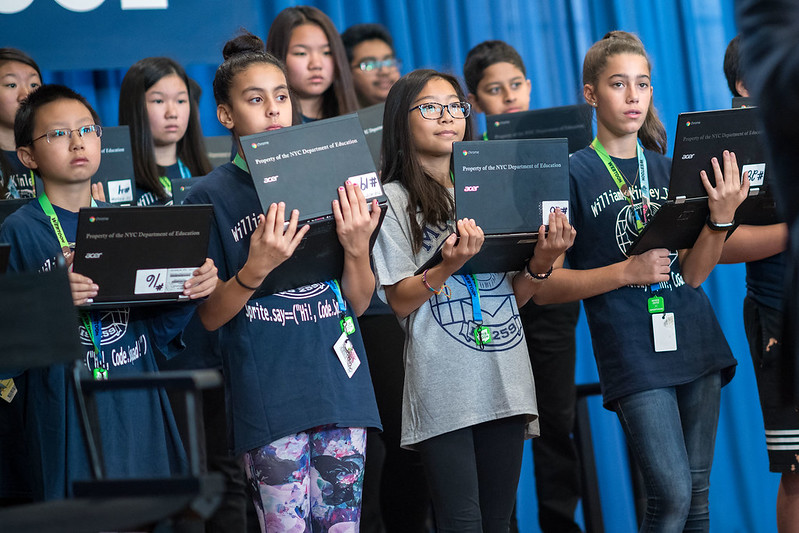
Getting students connected is one part (photo: Ed Reed/Mayor’s Office)
Despite millions of dollars spent and a variety of initiatives undertaken, too many New Yorkers still lack reliable online access at a time when it is more important than ever.
Reliable and fast connectivity is not a privilege, it’s essential. Without it, homes and businesses simply cannot succeed amid this public health crisis, which has forced many to live much of their lives virtually – from remote working and telehealth, to online learning, shopping, and socializing.
The need to close the digital divide is now a mandate for elected officials at all levels of government. The telecommunications industry is eager to improve service across the state. Unfortunately, a patchwork of regulations stymie investments.
For example, a fee implemented on the fiber in municipal rights-of-way, passed as part of the 2019-20 state budget, makes it cost prohibitive to expand online service to areas most in need. Underground fiber provides the backbone of a strong online network. Also, a recently proposed E-LEARN bill would layer on additional costs. In addition, state lawmakers have twice rejected the governor’s proposed statewide plan to streamline permitting of small cells, the technology necessary to facilitate the deployment of the next generation of wireless connectivity, known as 5G.
Students across the state face immense challenges getting online as schools shifted to all-virtual instruction in so many cases. Over 700,000 students and 18,000 teachers reportedly lack adequate connectivity, and the problem is particularly acute among Black and brown communities.
In New York City alone, 40% of households across the five boroughs don’t have both home and mobile internet connections while 18% have neither.
5G will help address the digital divide with faster speeds, expanded capacity, and lower latency. The vast majority of Americans – 81% in 2019 – own a smartphone, making mobile devices an opportunity to address lack of connectivity, especially for young people, low-income individuals and people of color, who are more likely to rely on a smartphone as their primary means of online access.
Corporate philanthropy has rallied to help students in need throughout the pandemic, offering free or reduced-rate internet and donating WiFi hotspots and laptops. Now, elected officials and policy-makers need to facilitate the buildout of a small cell network that will increase coverage, capacity, and advance 5G. To do so, New York City must open a long-awaited reservation period – the time when authorized companies are allowed to bid on the right to use and lease city infrastructure (street and traffic lights and utility poles) to install telecommunications boxes and antennae — and the state Legislature must remove the barriers to deployment.
Reliable online service capable of transmitting large amounts of data is also critical to the success of telehealth, use of which increased exponentially in the pandemic’s early days and shows no signs of abating in popularity. NYC Health + Hospitals, for example, announced its telehealth visits had soared from just 500 in mid-March to more than 235,000 televisits by early June. Telehealth not only helps reduce costs, but also improves access to care in underserved rural areas. But good internet is essential.
Experts predict it will take years for New York and the nation to recover from the economic devastation wrought by the pandemic. Next-generation connectivity has the power to transform almost every aspect of modern life and the ability to generate millions of dollars in revenue and thousands of jobs across the state.
Remote working, telehealth, online learning, commerce, entertainment and essential services, like 911, are all dependent on connectivity. However, we face many obstacles with expanding wired and wireless networks. If the city and state are serious about addressing the digital divide, keeping residents safe, and setting businesses up for success, it is well past time to think bigger than simply making internet subscriptions more affordable. We need the tools capable of ushering us into a world of virtual possibility – we need to enhance the current 4G infrastructure and deploy 5G.
***
Ana Rua is Government Affairs Manager at Crowne Castle.
***
Have an op-ed idea or submission for Gotham Gazette? Email This email address is being protected from spambots. You need JavaScript enabled to view it.




